
Fynbos is a small belt of natural shrubland or heathland vegetation located in the Western Cape and Eastern Cape provinces of South Africa. This area is predominantly coastal and mountainous, with a Mediterranean climate and rainy winters. The fynbos ecoregion is within the Mediterranean forests, woodlands, and scrub biome. In fields related to biogeography, fynbos is known for its exceptional degree of biodiversity and endemism, consisting of about 80% species of the Cape floral kingdom, where nearly 6,000 of them are endemic. This land continues to face severe human-caused threats, but due to the many economic uses of the fynbos, conservation efforts are being made to help restore it.

Kniphofia is a genus of perennial flowering plants in the family Asphodelaceae, first described as a genus in 1794. All species of Kniphofia are native to Africa. Common names include tritoma, red hot poker, torch lily and poker plant.

Kirstenbosch is an important botanical garden nestled at the eastern foot of Table Mountain in Cape Town. The garden is one of 10 National Botanical Gardens covering five of South Africa's six different biomes and administered by the South African National Biodiversity Institute (SANBI). Prior to 1 September 2004, the institute was known as the National Botanical Institute.

Digitalis purpurea, the foxglove or common foxglove, is a toxic species of flowering plant in the plantain family Plantaginaceae, native to and widespread throughout most of temperate Europe. It has also naturalized in parts of North America, as well as some other temperate regions. The plant is a popular garden subject, with many cultivars available. It is the original source of the heart medicine digoxin. This biennial plant grows as a rosette of leaves in the first year after sowing, before flowering and then dying in the second year. It generally produces enough seeds so that new plants will continue to grow in a garden setting.

Stapelia is a genus of low-growing, spineless, stem succulent plants, predominantly from South Africa with a few from other parts of Africa. Several Asian and Latin American species were formerly included but they have all now been transferred to other genera. The flowers of certain species, most notably Stapelia gigantea, can reach 41 cm (16 inches) in diameter when fully open. Most Stapelia flowers are visibly hairy and generate the odor of rotten flesh when they bloom.
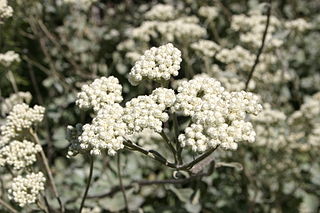
Helichrysum petiolare, the licorice-plant or liquorice plant, is a species of flowering plant in the family Asteraceae. It is a subshrub native to the Cape Provinces of South Africa — where it is known as imphepho — and to Angola, Zambia, and Zimbabwe. It is naturalized in parts of Portugal and the United States. Growing to about 45 cm (18 in) high and 150 cm (59 in) broad, it is a trailing evergreen subshrub with furry grey-green leaves and small white flowers. Other common names include silver-bush everlastingflower, trailing dusty miller and kooigoed. The foliage has a faint licorice aroma, but Helichrysum petiolare is not closely related to the true liquorice plant, Glycyrrhiza glabra.

Duvalia is a succulent plant genus in the subfamily Asclepiadoideae, in the family Apocynaceae (dogbane).
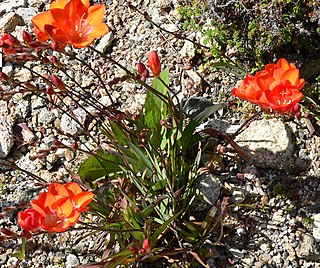
Tritonia is a genus of flowering plants in the iris family first described as a genus in 1802. They are naturally distributed across southern Africa, with a high concentration of species in Cape Province of western South Africa. The genus is closely related to the genus Ixia.

Senecio angulatus, also known as creeping groundsel and Cape ivy, is a succulent flowering plant in the family Asteraceae that is native to South Africa. Cape ivy is a scrambling herb that can become an aggressive weed once established, making it an invasive species. It is grown as an ornamental plant for its satiny foliage and sweet-scented flowers.
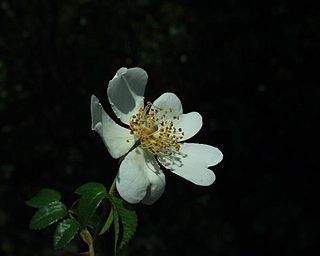
Rosa sempervirens, the evergreen rose, is a species of wild rose native to the Mediterranean. It is a climbing perennial with very prickly stems.
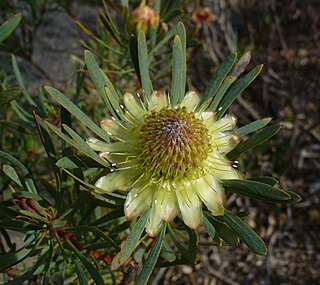
Protea scolymocephala, also known as the thistle protea or thistle sugarbush, is a flowering plant from the genus Protea native to South Africa.

The angulate tortoise is a species of tortoise found in dry areas and coastal scrub vegetation in South Africa. This tortoise is the only known member of the genus Chersina.

Salvia aurea is a shrubby evergreen perennial native to South Africa.

Salvia scabra is a herbaceous perennial native to the southeastern strand of the Cape of Good Hope in South Africa, growing on sandy shores, coastal brush, and hilly slopes up to an elevation of 600 feet. It was described and named by Carl Thunberg in 1800. The leaves and an extract from the roots have been used medicinally in its native region for at least one hundred years. Salvia scabra was introduced to California gardens around 1996, and is extremely adaptable to many types of conditions. Since then it has spread to gardens in England, France, and Italy.

Brabejum is a genus of a single species of large evergreen tree, Brabejum stellatifolium in the family Proteaceae, commonly called wild almond, bitter almond or ghoeboontjie. It is restricted in the wild to South Africa's Western Cape province, where it grows in thickets along the banks of streams. The plant is of botanical interest as being Africa's only member of the large grevilleoid subfamily. It is a bushy small tree with branches widely at ground level and numerous erect vigorous stems. Leaves grow up to 6 in (15 cm) long, narrow and bluntly toothed, appear at intervals along the branches, mostly in whorls of 6. In summer, the plant bears white flowers densely crowded on spikes arising from rusty buds at the leaf axils. The fruits to 2 in (5 cm) long, magenta to reddish brown, similar to an almond, appear in autumn. The nut is too bitter to eat; however, in earlier times it was boiled, roasted, and ground to make a "coffee" drink.
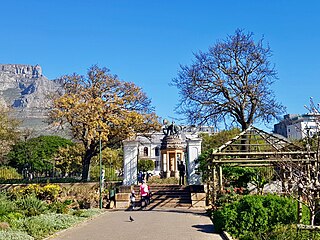
The Company's Garden is the oldest garden in South Africa, a park and heritage site located in central Cape Town. The garden was originally created in the 1650s by the region's first European settlers and provided fertile ground to grow fresh produce to replenish ships rounding the Cape. It is watered from the Molteno Dam, which uses water from the springs on the lower slopes of Table Mountain.

Jordaaniella is a genus of plants in the family Aizoaceae. The plants of this genus are indigenous to Namibia and South Africa's Cape Provinces in southern Africa. Seven species are accepted:

Jordaaniella anemoniflora, the anemone vygie, is a plant species in the family Aizoaceae. It is indigenous to a tiny area of the Cape Flats suburbs within the city of Cape Town, South Africa, but is now extinct in the wild.
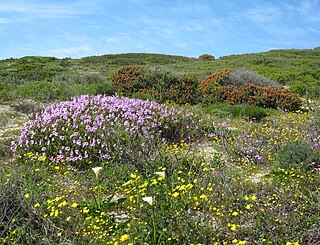
Cape Flats Dune Strandveld is an endangered vegetation type. This is a unique type of Cape Strandveld that is endemic to the coastal areas around Cape Town, including the Cape Flats.

Strelitzia alba also known as white-flowered wild banana, or Cape wild banana is a plant of the Bird of Paradise family and is endemic to the Garden Route along the southernmost coastal regions of the district of Humansdorp Eastern and district of Knysna in Western Cape in South Africa. It grows in evergreen forest, gorges, and on slopes along the rivers.



















